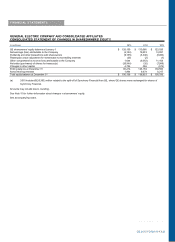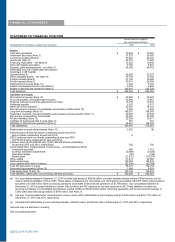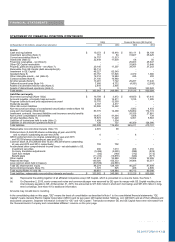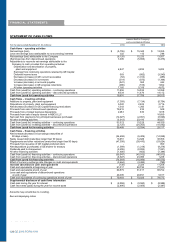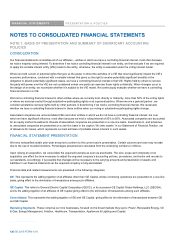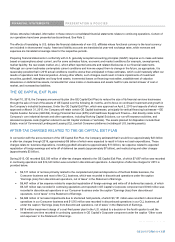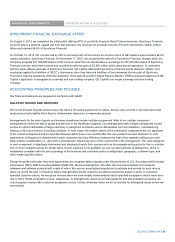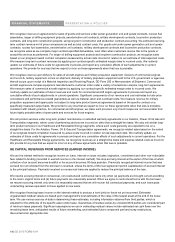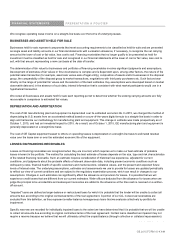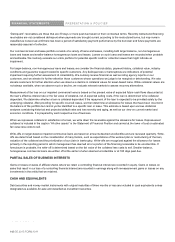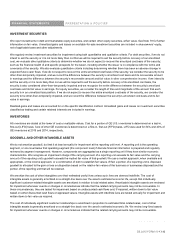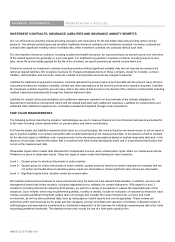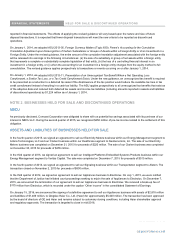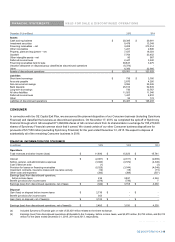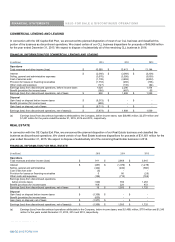GE 2015 Annual Report Download - page 169
Download and view the complete annual report
Please find page 169 of the 2015 GE annual report below. You can navigate through the pages in the report by either clicking on the pages listed below, or by using the keyword search tool below to find specific information within the annual report.
FINANCIAL STATEMENTS PRESENTATION & POLICIES
GE 2015 FORM 10-K 141
We recognize operating lease income on a straight-line basis over the terms of underlying leases.
BUSINESSES AND ASSETS HELD FOR SALE
Businesses held for sale represent components that meet accounting requirements to be classified as held for sale and are presented
as single asset and liability amounts in our financial statements with a valuation allowance, if necessary, to recognize the net carrying
amount at the lower of cost or fair value, less cost to sell. Financing receivables that no longer qualify to be presented as held for
investment must be classified as held for sale and recognized in our financial statements at the lower of cost or fair value, less cost to
sell, with that amount representing a new cost basis at the date of transfer.
The determination of fair value for businesses and portfolios of financing receivables involves significant judgments and assumptions.
Development of estimates of fair values in this circumstance is complex and is dependent upon, among other factors, the nature of the
potential sales transaction (for example, asset sale versus sale of legal entity), composition of assets and/or businesses in the disposal
group, the comparability of the disposal group to market transactions, negotiations with third party purchasers etc. Such factors bear
directly on the range of potential fair values and the selection of the best estimates. Key assumptions were developed based on market
observable data and, in the absence of such data, internal information that is consistent with what market participants would use in a
hypothetical transaction.
We review all businesses and assets held for sale each reporting period to determine whether the existing carrying amounts are fully
recoverable in comparison to estimated fair values.
DEPRECIATION AND AMORTIZATION
The cost of GE manufacturing plant and equipment is depreciated over its estimated economic life. In 2015, we changed the method of
depreciating its U.S. assets from an accelerated method based on a sum-of-the-years digits formula to a straight-line basis in order to
align and harmonize our methodology for manufacturing plant and equipment. This change in estimate was made prospectively as of
October 1, 2015, and had an immaterial impact for 2015. As a result, as of October 1, 2015, GE manufacturing plant and equipment is
generally depreciated on a straight-line basis.
The cost of GE Capital equipment leased to others on operating leases is depreciated on a straight-line basis to estimated residual
value over the lease term or over the estimated economic life of the equipment.
LOSSES ON FINANCING RECEIVABLES
Losses on financing receivables are recognized when they are incurred, which requires us to make our best estimate of probable
losses inherent in the portfolio. The method for calculating the best estimate of losses depends on the size, type and risk characteristics
of the related financing receivable. Such an estimate requires consideration of historical loss experience, adjusted for current
conditions, and judgments about the probable effects of relevant observable data, including present economic conditions such as
delinquency rates, financial health of specific customers and market sectors, collateral values, and the present and expected future
levels of interest rates. The underlying assumptions, estimates and assessments we use to provide for losses are updated periodically
to reflect our view of current conditions and are subject to the regulatory examination process, which can result in changes to our
assumptions. Changes in such estimates can significantly affect the allowance and provision for losses. It is possible that we will
experience credit losses that are different from our current estimates. Write-offs are deducted from the allowance for losses when we
judge the principal to be uncollectible and subsequent recoveries are added to the allowance at the time cash is received on a written-
off account.
"Impaired" loans are defined as larger-balance or restructured loans for which it is probable that the lender will be unable to collect all
amounts due according to the original contractual terms of the loan agreement. A portion of our CLL nonaccrual receivables are
excluded from this definition, as they represent smaller-balance homogeneous loans that we evaluate collectively by portfolio for
impairment.
Specific reserves are recorded for individually impaired loans to the extent we have determined that it is probable that we will be unable
to collect all amounts due according to original contractual terms of the loan agreement. Certain loans classified as impaired may not
require a reserve because we believe that we will ultimately collect the unpaid balance (through collection or collateral repossession).
GE 2015 FORM 10-K 141


